

The Willis organs of Hereford and Salisbury Cathedrals - a Comparative Look
2015-04-13 - Sample Set SpotlightI love the sound of an English cathedral organ! It is a unique and highly varied tonal palette that allows the performance of a large and diverse spectrum of musical styles. The great English builders, Willis, Harrison, Hill, Rushworth & Dreaper, Gray & Davidson, etc. all have certain things in common, but with noticeable differences as well. First and foremost, the organ must be able to fulfill its principle function as a "service playing" instrument. All other things are subject to this. In saying a service playing instrument, I mean that the organ must be completely capable of serving in the following capacities: 1) Accompanying the choir in a vast amount of vasty different repertoire. It must be able to play verse anthems by Byrd, and then "orchestrate" transcriptions of Mozart, Brahms, Schubert or Mendelssohn. It should sound "Bach-like" in accompanying items from the Passions and Cantatas, and it must play the romantic and extremely colorful "cathedral-style" works of composers such as Bairstow and Howells. In addition it must have the capabilities of playing the modern works of composers like Leighton, Mathias, and many others of all nationalities. 2) It must be able to lead the congregation in singing. Often these congregations can be huge, and playing hymns on "full organ" is almost a necessity! However playing loudly is not the basis of success. It must have a "singing quality", founded upon the grand Diapason chorus. 3) The organ must play the organ repertoire of all periods and styles with beauty, color, and "ear appeal". It may not be able to play the works of a composer like Franz Tunder with "authenticity," but it must play them convincingly, before turning to handle some Vierne, and then some Stanford, and... Well, the list would just go on and on!

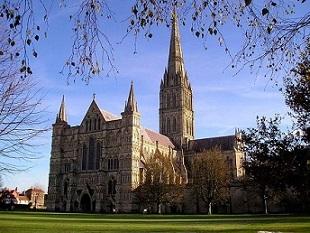
(Hereford Cathedral, on the left & Salisbury Cathedral on the right)
Both the Willis organs at Hereford and Salisbury achieve all of these requirements in similar, but different ways. Having played both of these organs and having made a lot of recordings with both sample sets, I'd like to offer some thoughts and "comparisons" between the two. These "thoughts" are mine only! They are honest opinions but do not serve to endorse one set above the other. Willis thought that the Salisbury organ was his greatest instrument, but the Hereford organ is a glorious one as well, so, let's begin our comparative tour! Both of these sample sets, like the organs they "simulate" are successful, but in ways that are often subtly different. Let's take a look at some of the similarities and differences, so we make a fair "comparison" of the two instruments.
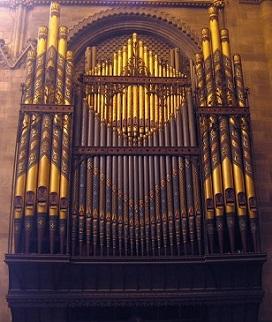
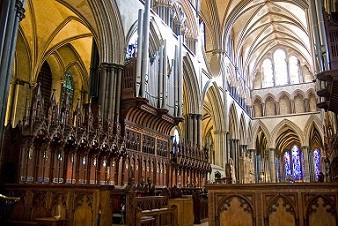
(Hereford pipes on the left & Salisbury pipes on the right.)
In order that our comparisons may have some sense of structure, let's look at the organs division by divsion. Both instruments are four manuals and pedal, so, let's start with the Great Organ. Both Greats are based upon the most English of sounds - the Open Diapason. Both organs have essentially two "choruses" as you will notice that there are "first and second" 8' Opens and 4' Principals. Hereford also has a third 8' Open (First Diapason), but it is very big, and has a beautiful and mournful tone. It's so large that it sounds almost like some Stentorphones that I've heard! We find a Twelfth at 2 2/3' and a Fifteenth at 2' in both organs. Salisbury has one 4-rank mixture, while Hereford has 2. The Mixture III, will go with either "chorus," but the Mixture IV wants the bigger, first chorus, at least to my ears. The Hereford mixtures can add more "sparkle" to the ensemble, but the one at Salisbury lacks for nothing, and always "does the job" beautifully. The Salisbury diapasons are velvety, helped by the acoustic's warmth. The Hereford ones are also sweet, but perhaps not quite as "warm" as the Salisbury ones. The Third (smallest) Diapason at Hereford is gorgeous! Both organs have two eight foot flutes - a Stopped Diapason (like a Gedeckt or Rohrflute) and an Clarabella (Harmonic flute). Both Salisbury flutes are sweet, while the Hereford Clarabella is big, and is almost like a hybrid stop, as it does not sound like a "pure" flute. Both organs have complete and independent reed choruses at 16', 8', and 4', and both are wonderful, but different in subtle ways.
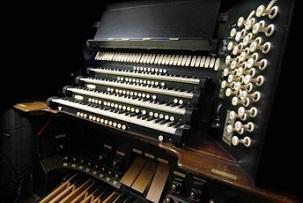
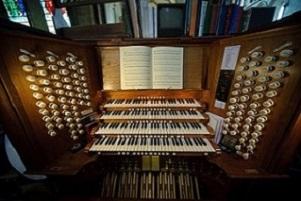
(Hereford console on the left & Salisbury console on the right.)
The Swell Organs are big divisions on both organs, and both of them are spectacular. These serve as the "color divisions" and are absolutely essential in accompaniments, etc. Both have complete choruses at 8', 4', 2' and Mixture. Both organs have a 16' String, rather than the more common, 16' Flute. I believe that Willis felt the string would be more "versatile" than the flute, and I think he was correct, although there are times when I'd MUCH rather have the 16' Bourdon! Salisbury has 4 reed ranks while Hereford has 5, the "extra" rank being the very nice (but very soft) Dulzian 16'. The main difference in the reeds themselves is that Salisbury has a Contra Fagotto for it's 16' reed while Hereford has a Double Trumpet. ("Double" meaning the "octave below the normal unison pitch" - not two trumpets!) Here again, the question of versatility comes into question. The Double Trumpet is bigger and perhaps "grander," but the Contra Fagotto gives you the chance of using it with Full Swell, or a "mini-Full Swell", so, my vote here would go to Salisbury. Both Oboes are beautiful, and are perhaps THE most necessary stop in the division. In proper usage, the Oboe sees double duty, both as a solo stop, and as part of the chorus. Nothing can "bridge" the sounds for adding and subtracting stops to the Swell like the oboe! It get's the reed "color" in there early, so you can add on top of it, and "remains" on as you come back down from Full Swell to a softer sound. It serves as a wonderful "background" color for most mezzo-forte sounds, and to me, is more valuable than I can express. The main "difference" in the reeds of the two organs is that Salisbury reeds have a "French influence" while Hereford is more "classically English". Both organs have very prominent 4' Clarions. I often reserve this stop for THE big climax, as adding it really dives a fiery brilliance to the sound. The strings are pretty on both organs. The Hereford strings sound almost "Aeolian Skinner-like," while Salisbury sounds more "European" in it's slightly darker, and slightly louder effect. The Swell at Hereford (the REAL one) is a bit more "buried" and you'll notice that when you close the box, it almost "disappears" behind the Great. This effect can be exciting, but for "general speech" the Salisbury Swell seems to have an ideal placement.
The Choir Organs are very different on the two instruments. It is a common error that English choirs are enclosed. Most are not - or perhaps WERE not would be more accurate. Certainly many were enclosed, but the "classic English choir" would have been unenclosed. It was intended to serve as an "accompanimental division," almost like a "small Great" division. You must remember that the choir division would usually be quite close to where the Choir (the singing one!) would be located, and the nearness would provide a soft but "present feel" to the sound. The color stops, and orchestral reeds (under expression) would be found on the Solo, and not on the Choir. Usually there would be a Clarinet or Cremona on the Choir, but without expression. Hereford and Salisbury both have 8' Trumpets, but other than the stop names, the two Choirs are signiificantly different. Salisbury's choir is larger and more romantic. In addition to the usual stops, Salisbury has greater variety in the flutes, and makes a nice ensemble, either on its own or coupled to the Swell. The main "problem" with the Hereford Choir (this is my opinion) is that it sounds "too close and narrow - almost nasal" in the quality of the tone. I don't recall the REAL one sounding quite like this, but I've noticed that when I record on Hereford and listen to the playback, the sounds seems OK, and not as "narrow" as it did when I was playing it. The Salisbury Choir does not have a "plenum" while Hereford does, but the sound is very thin and bright. It's a useful sound, if used with taste and discretion.

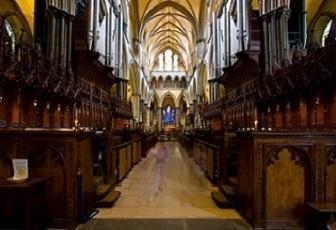
(Standing in the Nave, looking into the Quire - Hereford on the left & Salisbury on the right.)
The Solo Organs are quite different on the two instruments. Here it is Hereford that has the larger of the two divisions. Both organs have similar ranks of Harmonic Flutes, Solo Gambas, and a matching Celeste at 8' pitch, and both organs have 4' Harmonic Flutes, but Hereford also has a 2' Hohl Flute. Both organs have wonderful Clarinets and Orchestral Oboes, but the colors are a little different. Both organs have a Cor Anglais, but these are VERY different! The Hereford one at 8' is almost like a "2nd Clarinet" while Salisbury is at 16', and is darker and bigger. Almost like a Schalmei or miniature Trumpet. Hereford has the wonderful addition of an 8' Tromba under expression. It's almost like a "little Tuba" (although the color is definitely a tromba, and quite orchestral), and this can be used as a solo (it even works nicely with the tremulant!), or can be coupled to the full organ with the box closed, which, when opened, provides a wonderful "cap" to the full organ. Both organs have glorious Tubas! Salisbury has a Tuba Clarion 4', which is just the 8' unified to 4'. I think the Salisbury tuba is bigger, and has a bit more "fire" in it, while the Hereford is smooth and very noble. You'd have to pick your own favorite of these two, but I think that the one at Salisbury has been called "King of Tubas"! Hereford has several unique features on the Solo. One is a Glockenspiel (doesn't get much use from me!) and the other is a feature that allows you to play either the Clarinet, Tromba, or Orchestral Oboe at 16' or 8' pitch, as there are complete ranks of pipes to play the stop for the entire range. The Tremulants on both organs are not to my liking, but Hereford is more "even". Salisbury has some beautiful "tremmed" notes, then, all of a sudden, you've got one completely out of control! The tremulant is important, but when I want to use it, I make certain BEFORE starting the notes I'll be playing will sound OK, and that there is not a "Tremulated Land Mine" just hiding and waiting to explode! The Hereford Solo is bigger and more versatile, but I love the Salisbury sound, although choices for the solo colors are more limited.
So, finally we come to the Pedal Organ. Even in the great cathedral organs the Pedal is often "short changed" in that many stops are units, and that it sometimes seems like a necessary after-thought. Both organs have Open Diapasons (Open Woods) at 32' 16' 8' and 4', but Salisbury has First and Second Diapasons (metal) at 16', a Violone at 16, as while as the softest 16' borrowed from the Choir. It also has a Violoncello at 8'. Hereford only has three 16' stops, and the Bourdons at 16 and 8 especially suffer from heavy chiff on some notes. Hereford has "better" upperwork in the Pedal, but Salisbury is unmatched in the "fullness" of the feel of its Pedal - either soft or loud. Hereford probably wins the "Battle of the Pedal Reeds". Certainly it has more of them, so, let's look at them from the bottom up! The 32' reeds are SO necessary to give that god-like feel to the sound. The "thunder from down under" is a part of the whole cathedral sound picture. Hereford probably wins this round, as its fabulous Bombarde is more than loud. In reality, it's NOT the volume but the "heaviness" of it that makes it for me. It has a LOT of fundamental in it, and provides more foundation than the reed at Salisbury. Granted, the Salisbury reed is a Kontra Posaune and not a Bombarde, but while it's big in the middle and upper registers, it disappoints me in the low end. I don't recall the REAL one being so "thin" at the very bottom, but my memory may not be entirely accurate. Both organs have splendid 16' Ophicleides. The Trumpet 8' at Hereford is more "balanced" with the 16', while the Salisbury 8' is not called a Trumpet, but is a Clarion. There is NO 4' reed at Salisbury, and the 8' Clarion is very big. Hereford also has a 16' Tuba, which has many useful functions, being the Pedal reed in a Bach Prelude and Fugue, being one of them. While I'd give the award to the Salisbury foundations, Hereford would win in the reed category.
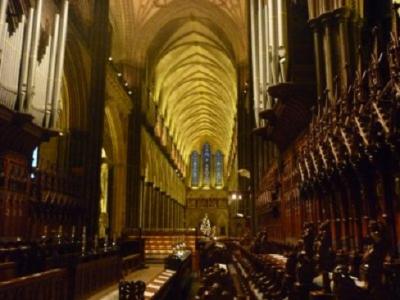
(In the Quire of Salisbury with the organ above on both sides, and looking West down the Nave.)
Lastly, let's look at the "special features" of the two organs. Salisbury has the very useful capability of a "transfer" that allows the organist to play the Great reeds on either the Solo or the Choir. This would allow you to draw the Diapasons and say, the Trumpet 8' on the Great, play the trumpet as a solo on either the Solo or the Choir accompanied by the Great diapasons. Hereford is the ONLY English cathedral organ that I now of that has a crescendo pedal! I'm generally not a fan of crescendo pedals because they lead to laziness, and your crescendos and diminuendos are subject to what the organ wants. I don't have an "expression shoe" available to use as a crescendo, but I have to say that the Hereford crescendo pedal is functional, useful and beautiful in it's effect. If I were going to use a crescendo pedal, THIS would be the one!
The prize for the Hauptwerk features, the computer screens, the virtual console, etc. goes to Hereford, which has a beautiful and completely functioning virtual console. It is always disappointing to realize that Salisbury has NO virtual console. Does it effect the sound? Of course not! However, each time I play the Salisbury set, and I play it a lot, I wish for a virtual console to magically appear...
So, there you have a comparison of these two amazing virtual instruments. I congratulate Lavender Audio for the outstanding accomplishment in this wonderful sample set of Hereford Cathedral. Great praise also to Milan Digital Audio for the achievement of the superb Salisbury Cathedral sample set. I can only hope that we can hope to see more sample sets forthcoming from both companies in the near future!
I hope this review was helpful, and I plan on doing my reviews over the coming months. I will only review sample sets that I OWN and USE! Reviewing something that I am not familiar with would be unfair and pointless. Please feel free to comment or to discuss this further!
With best regards to all,
David
Comments
Very informative. As was already stated, this lends a definition to cathedral organs, especially the English variety.
Your contributions, written and musical, are greatly appreciated.
Bob
As one of my friends keeps reminding me, wishing for the best of both worlds could lead to a real "Frankenstein's Monster" of stitched up ranks that don't cooperate - yet that is what I yearn for. Ho hum.
As a composer, I find that the Salisbury instrument satisfies my needs for various tone colours and weights. Mind you, the first time I tried the Tuba, it gave me quite a start: it's weight of tone is truly impressive.
However, I would like, at some point, to acquire the Hereford set as well. For me, the Solo Tromba and Pedal Bombarde would be nice to have, and who wouldn't want a third Diapason on the Great? Also, the Solo Tuba seems a little more tractable than the fearsome brute that tops the Salisbury plenum.
Thanks - and I look forward to more reviews in the future.